The Use of Computer Records: A Tool to Increase Productivity in Dairy Herds
Simple Summary
Abstract
1. Introduction
2. Materials and Methods
2.1. Selection of Years per Herdand Variables
- ▪
- Age at first calving (AFC): The average of the months since birth to the first calving for all the females with a first calving in the respective year per herd.
- ▪
- Days open (DO): Average of the days since calving until the confirmed conception, for all the cows that conceived in the respective year per herd.
- ▪
- Daily milk yield (DMY): Average in kilos per cow estimated from all the daily individual weighing in the respective year per herd.
- ▪
- Productive life (PL): Average of years in production since the first calving until culling, for all the cows with record of cull in the respective year per herd.
- ▪
- Incidence of mastitis during lactation (MAST): Percentage of lactations with at least one event reported with clinical mastitis, regarding the total of lactations started in the respective year per herd.
- ▪
- Incidence of lameness during lactation (LAM): Percentage of lactations with at least one reported event of a lameness, regarding the total of lactations started in the respective year per herd.
Grouping of the Herds According to Their Adoption Level of the VAMPP®Bovine Program
2.2. Statistical Trend Analysis
2.3. Cost–Benefit Analysis
3. Results
3.1. Reproductive Performance Variables
3.2. Production Variables
3.3. Health Variables
3.4. Cost–Benefit Analysis by Partial Budgetting
4. Discussion
4.1. Reproductive Category
4.2. Production Domain
4.3. Health Category
4.4. Cost–Benefit
4.5. Final Considerations
5. Conclusions
Author Contributions
Funding
Acknowledgments
Conflicts of Interest
References
- González-Padilla, E.; Lassala, A.; Pedernera, M.; Gutierrez, C.G. Cow-calf management practices in Mexico: Farm organization and infrastructure. Vet. Mex. 2019, 6, 1–17. [Google Scholar] [CrossRef]
- Pérez, A.; Milla, M.; Mesa, M. Impacto de las tecnologías de la información y la comunicación en la agricultura. Cultiv. Trop. 2006, 27, 11–17. [Google Scholar]
- Aparicio, F.F. TICs y sociedad: Salvando la brecha digital. El caso de Extremadura: Los nuevos centros del conocimiento y el software libre. Rev. Latinoam. Tecnol. Educ. 2004, 3, 29–44. [Google Scholar]
- Sánchez, G.Z. Sistemas de Registro Computarizado ¿Es Posible la Adopción Bajo las Condiciones de un Pequeño Productor? Master’s Thesis, Universidad Nacional Autónoma de México, Mexico City, Mexico, 2015; 57p. [Google Scholar]
- Verstegen, J.A.; Huirne, R.B.; Dijkhuizen, A.A.; Kleijnen, J.P. Economic value of management information systems in agriculture: A review of evaluation approaches. Comput. Electron. Agric. 1995, 13, 273–288. [Google Scholar] [CrossRef]
- Jones, E.; Batte, M.T.; Schnitkey, G.D. A socioeconomic analysis of marketing information usage among Ohio fruit producers. South. J. Agric. Econ. 1990, 22, 99–107. [Google Scholar] [CrossRef]
- Amponsah, W.A. Computer adoption and use of information services by North Carolina commercial farmers. J. Agric. Appl. Econ. 1995, 27, 565–576. [Google Scholar] [CrossRef]
- Dedrick, J.; Gurbaxani, V.; Kraemer, K.L. Information technology and economic performance: A critical review of the empirical evidence. ACM Comput. Surv. 2003, 35, 1–28. [Google Scholar] [CrossRef]
- Losinger, W.C.; Heinrichs, A.J. Dairy operation management practices and herd milk production. J. Dairy Sci. 1996, 79, 506–514. [Google Scholar] [CrossRef]
- Tomaszewski, M.A.; Dijkhuizen, A.A.; Hengeveld, A.G.; Wilmink, H. A method to quantify effects attributable to management information systems in livestock farming. In Proceedings of the First European Conference for Information Technology in Agriculture, Copenhagen, Denmark, 15–18 June 1997; pp. 183–188. [Google Scholar]
- Morris, C.; Loveridge, A.; Fairweather, J.R. Understanding why Farmers Change Their Farming Practices: The Role of Orienting Principles in Technology Transfer; Agribusiness & Economics Research Unit: Canterbury, New Zealand, 1995. [Google Scholar]
- Van Asseldonk, M.A.P.M.; Huirne, R.B.M.; Dijkhuizen, A.A.; Beulens, A.J.M.; Ten Cate, A.U. Information needs and information technology on dairy farms. Comput. Electron. Agric. 1999, 22, 97–107. [Google Scholar] [CrossRef]
- Griffith, R.; Huergo, E.; Mairesse, J.; Peters, B. Innovation and productivity across four European countries. Oxf. Rev. Econ. Policy 2006, 22, 483–498. [Google Scholar] [CrossRef]
- Parisi, M.L.; Schiantarelli, F.; Sembenelli, A. Productivity, innovation and R&D: Micro evidence for Italy. Eur. Econ. Rev. 2006, 50, 2037–2061. [Google Scholar]
- Varela, M. Impacto de los Instrumentos de Transferencia de Tecnológica Agropecuaria en Chile; Consejo Nacional de Innovación para la Competitividad; Fundación Chile: Santiago, MN, USA, 2010. [Google Scholar]
- Romero, J.J.; Rojas, J.; Estrada, S. El programa VAMPP bovino® como herramienta de apoyo a la toma de decisiones en los sistemas de producción bovinos. Ventana Leche. 2011, 5, 4–14. [Google Scholar]
- Instituto Nacional de Estadísticas y Censos (INEC). VI Censo Nacional Agropecuario: Resultados Generales, 1st ed.; INEC: San José, Costa Rica, 2015.
- Vargas Leitón, B. Mejoramiento Genético: Herramienta para Incrementar la Productividad del hato Lechero; UTN-Informa: Quesada, Costa Rica, 2013; Volume 66, pp. 6–14. [Google Scholar]
- Iñamagua-Uyaguari, J.P.; Jenet, A.; Alarcón-Guerra, L.G.; Vilchez-Mendoza, S.J.; Casasola-Coto, F.; Wattiaux, M.A. Impactos económicos y ambientales de las estrategias de alimentación en lecherías de Costa Rica. Agron. Mesoam. 2016, 27, 1–17. [Google Scholar] [CrossRef]
- Schabenberger, O. Introducing the GLIMMIX procedure for generalized linear mixed models. In Proceedings of the SAS Users Group International conference, Philadelphia, PA, USA, 10–13 April 2005. [Google Scholar]
- SAS/STAT® User’s Guide: Statistics; Version 9.2; SAS Inst. Inc.: Cary, NC, USA, 2009.
- Holdridge, L.R. Ecología Basada en Zonas de Vida; 5ta reimp: San José, Costa Rica, 2000. [Google Scholar]
- Reyes-Hernández, M. Análisis Económico de Experimentos Agrícolas con Presupuestos Parciales: Re-enseñando el uso de este Enfoque. Available online: https://lacalera.una.edu.ni/index.php/CALERA/article/view/28 (accessed on 23 December 2019).
- Vargas-Leitón, B.; Cuevas-Abrego, M. Modelo estocástico para estimación de valores económicos de rasgos productivos y funcionales en bovinos lecheros. Agrociencia 2009, 43, 881–893. [Google Scholar]
- Ministerio de Trabajo y Seguridad Social (MTSS). Lista de Salarios. 19-06-2017, de Ministerio de Trabajo y Seguridad Social; MTSS: San José, Costa Rica, 2017.
- Alfaro, R.; Guerrón, R. Evaluación productiva y reproductiva de las razas Holstein, Jersey y sus cruzamientos, en la región de San Carlos, Costa Rica, utilizando el programa VAMPP®. Master’s Thesis, Escuela Agrícola Panamericana, Universidad Zamorano, HN, 2012; 38p. Available online: https://bdigital.zamorano.edu/bitstream/11036/837/1/T2529.pdf (accessed on 23 December 2019).
- Rivera, J.A.; Anta, E.; Galina, C.; Porras, A.; Zarco, L. Análisis de la Información Publicada en México Sobre Eficiencia Reproductiva de los Bovinos. Vet. Mex. 1989, 20, 11–18. [Google Scholar]
- Castillo, G.; Vargas, B.; Hueckmann, F.; Romero, J. Factores del animal y el manejo predestete que afectan la edad al primer parto en hatos de lechería especializada de Costa Rica. Agron. Costarric. 2019, 43, 9–24. [Google Scholar] [CrossRef]
- Loeffler, S.H.; De Vries, M.J.; Schukken, Y.H.; De Zeeuw, A.C.; Dijkhuizen, A.A.; De Graaf, F.M.; Brand, A. Use of AI technician scores for body condition, uterine tone and uterine discharge in a model with disease and milk production parameters to predict pregnancy risk at first AI in Holstein dairy cows. Theriogenology 1999, 51, 1267–1284. [Google Scholar] [CrossRef]
- Lucy, M.C. Reproductive loss in high-producing dairy cattle: Where will it end? J. Dairy Sci. 2001, 84, 1277–1293. [Google Scholar] [CrossRef]
- Galvis, R.D.; Múnera, E.A.; Marín, A.M. Relación entre el mérito genético para la producción de leche y el desempeño metabólico y reproductivo en la vaca de alta producción. Rev. Colomb. Cienc. Pecu. 2005, 18, 228–239. [Google Scholar]
- Ahmadzadeh, A.; Frago, F.; Shafii, B.; Dalton, J.C.; Price, W.J.; McGuire, M.A. Effect of clinical mastitis and other diseases on reproductive performance of Holstein cows. Anim. Reprod. Sci. 2009, 112, 273–282. [Google Scholar] [CrossRef]
- Walsh, S.W.; Williams, E.J.; Evans, A.C.O. A review of the causes of poor fertility in high milk producing dairy cows. Anim. Reprod. Sci. 2011, 123, 127–138. [Google Scholar] [CrossRef]
- Aviléz, J.P.; Escobar, P.; Von Fabeck, G.; Villagrán, K.; García, F.; Matamoros, R.; García, A. Caracterización productiva de explotaciones lecheras empleando metodología de análisis multivariado. Rev. Cient. Fac. Cienc. Vet. 2010, 20, 74–80. [Google Scholar]
- Tomaszewski, M.A.; Asseldonk, M.A.P.M.; Dijkhuizen, A.A.; Huirne, R.B.M. Determining farm effects attributable to the introduction and use of a dairy management information system in The Netherlands. Agric. Econ. 2000, 23, 79–86. [Google Scholar] [CrossRef]
- Stevenson, M.A.; Lean, I.J. Descriptive epidemiological study on culling and deaths in eight dairy herds. Aust. Vet. J. 1998, 76, 482–488. [Google Scholar] [CrossRef]
- Vargas, B.; Cedeño, D.A. Efecto de la raza y el manejo sobre la vida productiva del bovino lechero en Costa Rica. Arch. Zootec. 2004, 53, 129–140. [Google Scholar]
- Vukasinovic, N.; Moll, J.; Künzi, N. Analysis of productive life in Swiss Brown cattle. J. Dairy Sci. 1997, 80, 2572–2579. [Google Scholar] [CrossRef]
- Vargas, B.; Herrero, M.; Van Arendonk, J.A.M. Interactions between optimal replacement policies and feeding strategies in dairy herds. Livest. Prod. Sci. 2001, 69, 17–31. [Google Scholar] [CrossRef]
- Pritchard, T.; Coffey, M.; Mrode, R.; Wall, E. Understanding the genetics of survival in dairy cows. J. Dairy Sci. 2013, 96, 3296–3309. [Google Scholar] [CrossRef]
- Van Asseldonk, M.A.P.M.; Huirne, R.B.M.; Dijkhuizen, A.A.; Beulens, A.J.M. Determining the optimum investment pattern in information technology on dairy farms. In Proceedings of the Dutch/Danish Symposium on Animal Health and Management Economics, Copenhagen, Denmark, 23–24 January 1997; Volume 56, pp. 81–85. [Google Scholar]
- Mora, M.G.; Vargas, B.; Romero, J.J.; Camacho, J. Factores de riesgo para la incidencia de mastitis clínica en ganado lechero de Costa Rica. Agron. Costarric. 2015, 39, 77–89. [Google Scholar]
- Vargas, B.; Solís, O.; Sáenz, F.; León, H. Caracterización y clasificación de hatos lecheros en Costa Rica mediante análisis multivariado. Agron. Mesoam. 2013, 24, 257–275. [Google Scholar] [CrossRef]
- Solano, M.; Vargas, B.; Saborío, A.; Pichardo, D. Factores genéticos y ambientales en lesiones podales del ganado lechero en Costa Rica. Agron. Mesoam. 2018, 29, 123–140. [Google Scholar] [CrossRef]
- Bergsten, C. Effects of conformation and management system on hoof and leg diseases and lameness in dairy cows. Vet. Clin. N. Am. Food Anim Pract. 2001, 17, 1–23. [Google Scholar] [CrossRef]
- Solano, L.; Barkema, H.W.; Pajor, E.A.; Mason, S.; LeBlanc, S.J.; Heyerhoff, J.Z.; Rushen, J. Prevalence of lameness and associated risk factors in Canadian Holstein-Friesian cows housed in freestall barns. J. Dairy Sci. 2015, 98, 6978–6991. [Google Scholar] [CrossRef]
- Argiles, J.M.; Slof, E.J. The use of financial accounting information and firm performance: An empirical quantification for farms. Account Bus Res. 2003, 33, 251–273. [Google Scholar] [CrossRef]
- Nuthall, P.L. Case studies of the interactions between farm profitability and the use of a farm computer. Comput. Electron. Agric. 2004, 42, 19–30. [Google Scholar] [CrossRef]
- Rose, D.; Sutherland, W.; Parker, C.; Lobley, M.; Winter, M.; Morris, C.; Twining, S.; Foulkes, C.; Amano, T.; Dicks, L. Decision support tools for agriculture: Towards effective design and delivery. Agric. Syst. 2016, 149, 165–174. [Google Scholar] [CrossRef]
- Fountas, S.; Carli, G.; Sørensen, C.; Tsiropoulos, Z.; Cavalaris, Z.; Vatsanidou, A.; Liakos, B.; Canavari, M.; Wiebensohn, J.; Tisserye, B. Farm management information systems: Current situation and future perspectives. Comput. Electron. Agric. 2015, 115, 40–50. [Google Scholar] [CrossRef]
- Tsiropoulos, Z.; Carli, G.; Pignatti, E.; Fountas, S. Future perspectives of farm management information systems. In Precision Agriculture: Technology and Economic Perspectives, Progress in Precision Agriculture; Pedersen, S.M., Lind, K.M., Eds.; Springer International Publishing: Cham, Switzerland, 2017; pp. 181–200. [Google Scholar]
- Kaler, J.; Ruston, A. Technology adoption on farms: Using Normalisation Process Theory to understand sheep farmers’ attitudes and behaviors in relation to using precision technology in flock management. Prev. Vet. Med. 2019, 170. [Google Scholar] [CrossRef]
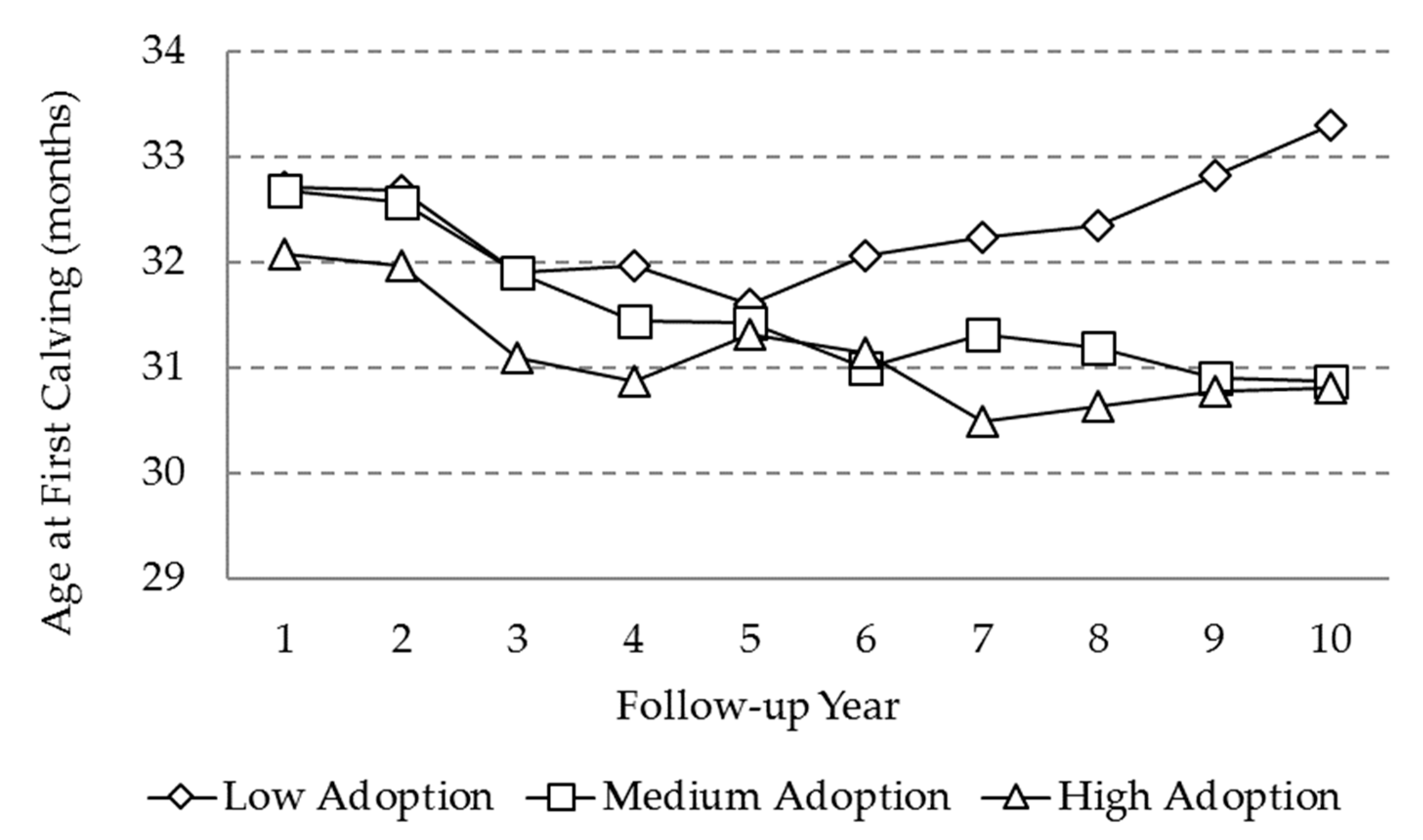
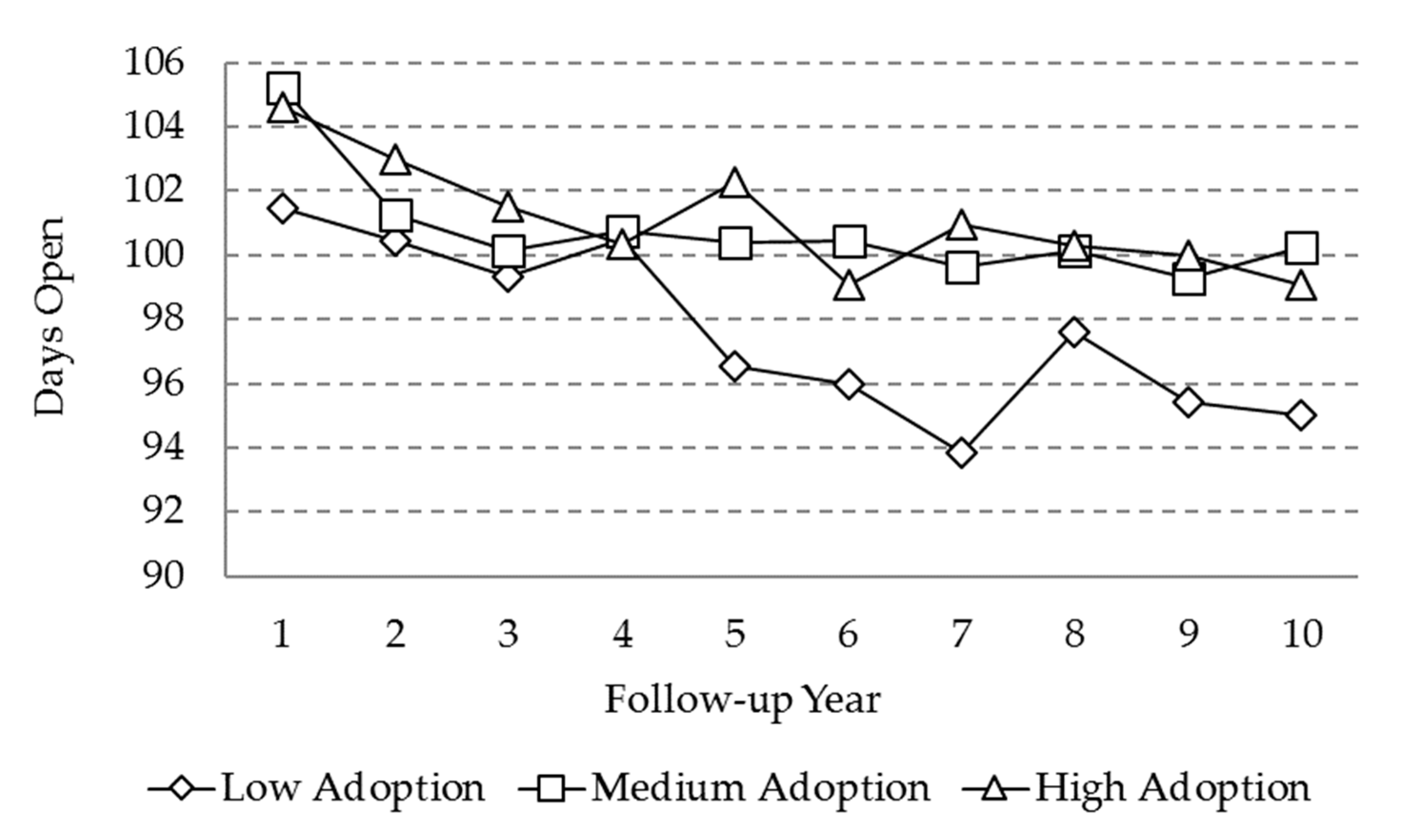
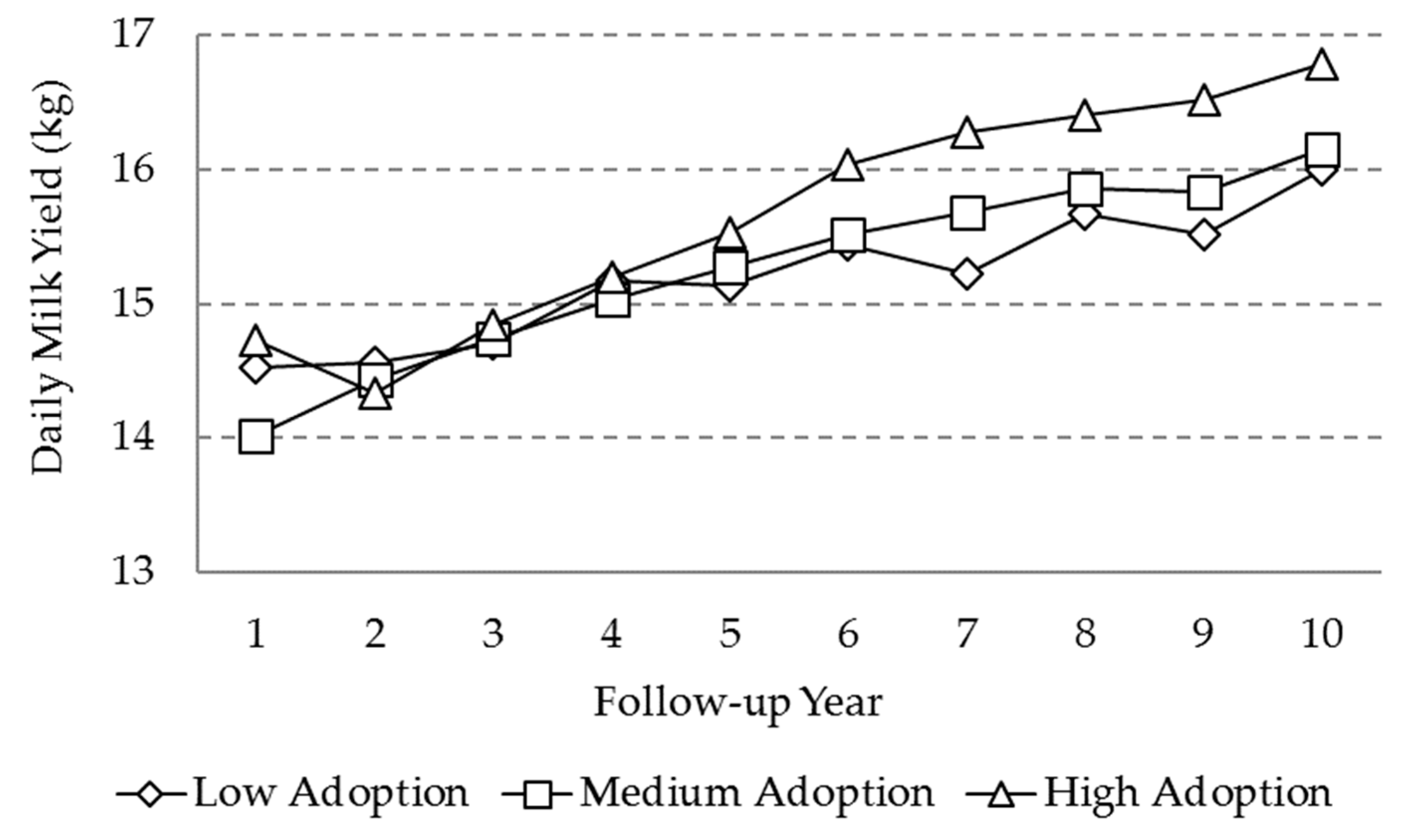
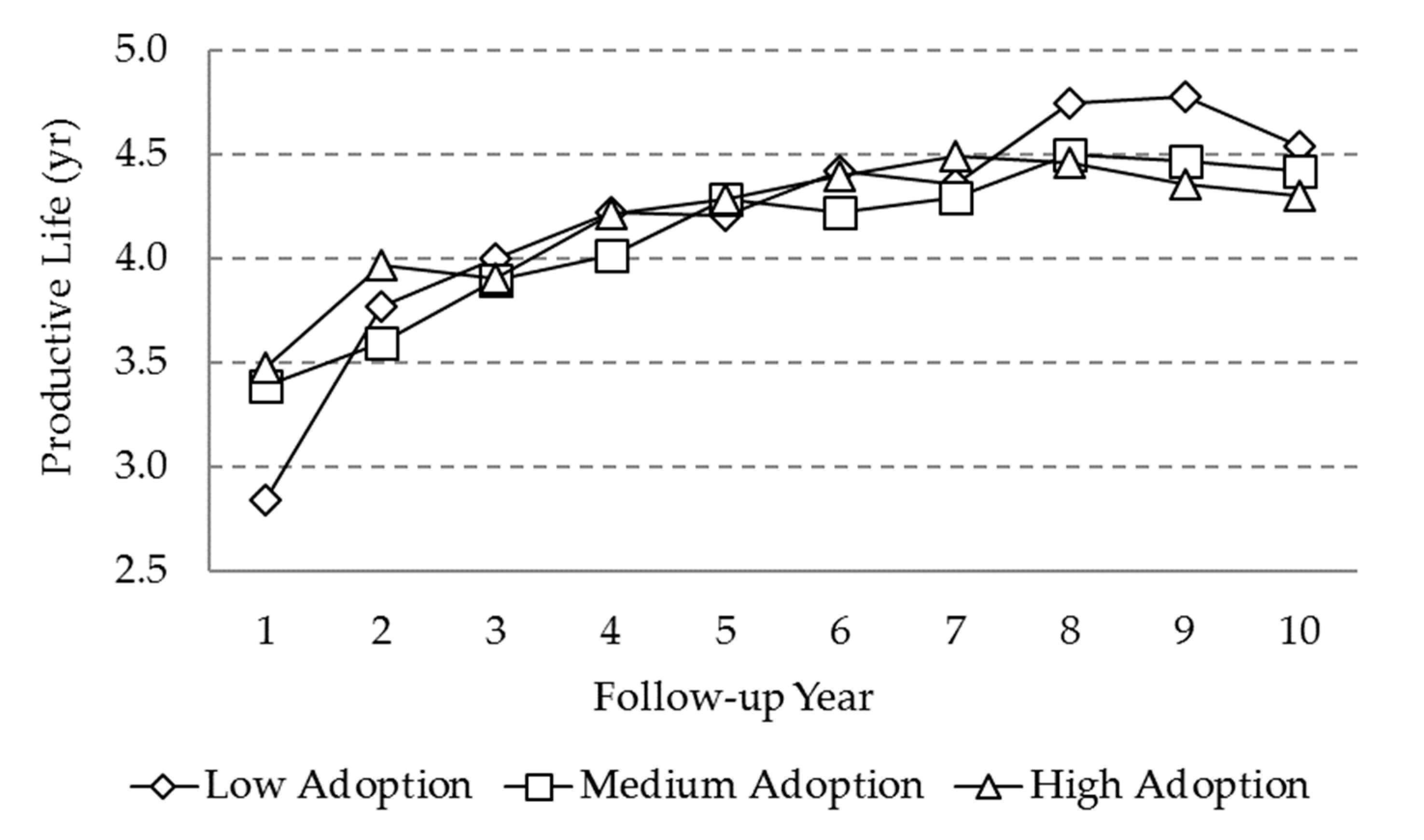
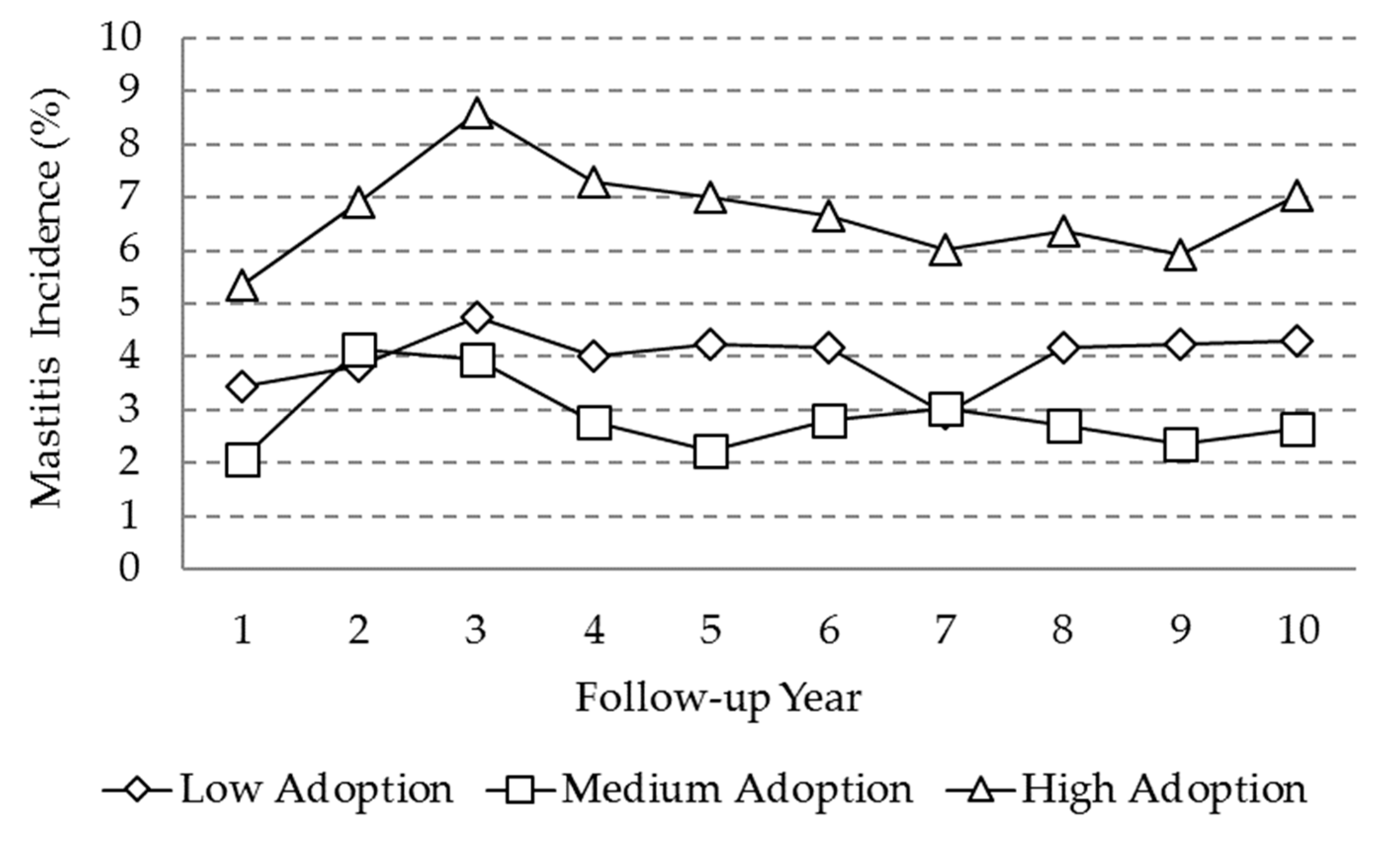
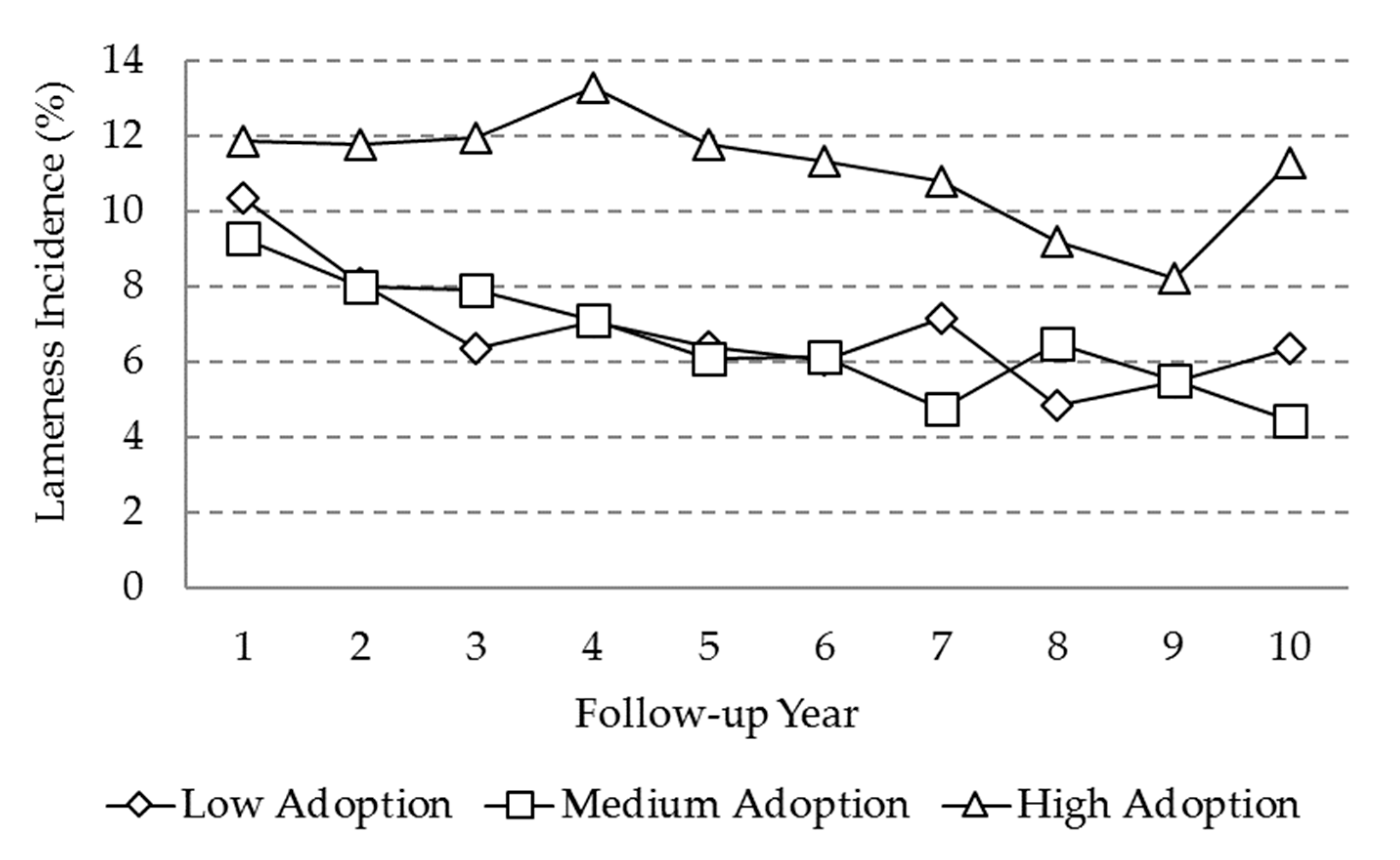
| Parameters | Score | Adoption Level A | ||
|---|---|---|---|---|
| Low | Medium | High | ||
| Reproductive category | ||||
| Age at first calving (AFC) | Months | (+) | (+) | (+) |
| Days open (DO) | Days | (+) | (+) | (+) |
| Productive category | ||||
| Daily milk yield (DMY) | kg | (-) | (+) | (+) |
| Productive life (PL) | Years | (-) | (+) | (+) |
| Health category | ||||
| Mastitis incidence (MAST) | % | (-) | (-) | (+) |
| Lameness incidence (LAM) | % | (-) | (-) | (+) |
| Variable | Score | Herds per Year | SD | 95% Confidence Limits | ||
|---|---|---|---|---|---|---|
| Lower | Higher | |||||
| Age at first calving (AFC) | Month | 7901 | 31.3 | 4.8 | 31.2 | 31.5 |
| Days open (DO) | Day | 7857 | 100.6 | 16.1 | 100.2 | 100.9 |
| Daily milk yield (DMY) | kg | 4363 | 16.7 | 4.5 | 16.6 | 16.9 |
| Productive life (PL) | Year | 6326 | 4.02 | 1.45 | 3.98 | 4.06 |
| Mastitis incidence (MAST) | % | 1675 | 10.9 | 10.7 | 10.4 | 11.5 |
| Lameness incidence (LAM) | % | 1287 | 17.9 | 17.4 | 16.9 | 18.9 |
| Effects of the Model | Significance Values (p) | |||||
|---|---|---|---|---|---|---|
| AFC | DO | DMY | PL | MAST | LAM | |
| Fixed | ||||||
| Herd size | <0.001 | <0.97 | 0.26 | 0.48 | <0.001 | <0.001 |
| Predominant breed | <0.001 | <0.001 | <0.001 | 0.44 | 0.30 | 0.58 |
| Agroecological zone | <0.001 | <0.01 | <0.001 | 0.65 | 0.71 | 0.80 |
| Calendar period | <0.001 | <0.001 | <0.01 | <0.001 | <0.01 | <0.001 |
| Adoption level VAMPP | <0.001 | <0.001 | 0.35 | <0.48 | <0.001 | <0.001 |
| Follow-up year VAMPP | <0.001 | <0.001 | <0.001 | <0.001 | <0.01 | 0.09 |
| Adoption level × follow-up year | <0.001 | <0.001 | 0.15 | <0.01 | 0.60 | 0.63 |
| Random A | ||||||
| Between herds | <0.001 | <0.001 | <0.001 | <0.001 | <0.001 | <0.001 |
| Intra herds | <0.001 | <0.001 | <0.001 | <0.001 | <0.001 | <0.001 |
| Parameters | Scale | Value | |
|---|---|---|---|
| Expected increase in costs: | |||
| Investment in hardware A | USD/year | $140 | |
| Investment in software B | USD/year | $140 | |
| Data collection C | USD/year/100 cows | $188 | |
| Data entry and information analysis C | USD/year/100 cows | $376 | |
| Total increase of costs (∆C) | USD/5 year/100 cows | $4219 | |
| Expected increase in income: | DO (d) | DMY (kg) | |
| Expected annual change in trait D | unit/cow/year | −1.02 | 0.31 |
| Economic value of the trait E | USD/unit/cow/year | −$2.15 | $64.6 |
| Increase in income by trait | USD/5 year/100 cows | $1097 | $10,013 |
| Total increase of income (∆I) | USD/5 year/100 cows | $11,110 | |
| Gross margin (∆GMMIS = ∆I − ∆C) | USD/5year/100 cows | $6890 | |
| Marginal return rate (MRRMIS = ∆GM/∆C) | % | 163.3% |
| Variables | Correlation A (r) | GMMIS ($) | Change B ($) | MRRMIS (%) | Change B (%) |
|---|---|---|---|---|---|
| Base situation: | (6890) | (163.3) | |||
| Annual change in daily milk yield | 0.58 | ||||
| −10% (0.28 kg/year) | 5889 | −1001 | 139.6 | −23.7 | |
| +10% (0.34 kg/year) | 7892 | 1002 | 187.0 | 23.7 | |
| Annual change in days open | −0.07 | ||||
| −10% (−1.12 d) | 7000 | 110 | 165.9 | 2.6 | |
| +10% (−0.92 d) | 6781 | −109 | 160.7 | −2.6 | |
| Herd size | 0.48 | ||||
| −10% (90 cows) | 6061 | −829 | 153.9 | −9.4 | |
| +10% (110 cows) | 7719 | 829 | 171.5 | 8.2 | |
| Costs (data entry and analysis) | −0.11 | ||||
| −10% ($22.2) | 7078 | 188 | 175.6 | 12.3 | |
| +10% ($27.2) | 6703 | −187 | 152.1 | −11.2 | |
| Cost (data collection) | −0.05 | ||||
| −10% ($22.2) | 6984 | 94 | 169.3 | 6.0 | |
| +10% ($27.2) | 6796 | −94 | 157.6 | −5.7 | |
| Cost (software and hardware) | −0.04 | ||||
| −10% ($630) | 6960 | 70 | 167.8 | 4.5 | |
| +10% ($770) | 6820 | −70 | 159.0 | −4.3 |
© 2020 by the authors. Licensee MDPI, Basel, Switzerland. This article is an open access article distributed under the terms and conditions of the Creative Commons Attribution (CC BY) license (http://creativecommons.org/licenses/by/4.0/).
Share and Cite
Sánchez, Z.; Galina, C.S.; Vargas, B.; Romero, J.J.; Estrada, S. The Use of Computer Records: A Tool to Increase Productivity in Dairy Herds. Animals 2020, 10, 111. https://doi.org/10.3390/ani10010111
Sánchez Z, Galina CS, Vargas B, Romero JJ, Estrada S. The Use of Computer Records: A Tool to Increase Productivity in Dairy Herds. Animals. 2020; 10(1):111. https://doi.org/10.3390/ani10010111
Chicago/Turabian StyleSánchez, Zazil, Carlos Salvador Galina, Bernardo Vargas, Juan José Romero, and Sandra Estrada. 2020. "The Use of Computer Records: A Tool to Increase Productivity in Dairy Herds" Animals 10, no. 1: 111. https://doi.org/10.3390/ani10010111
APA StyleSánchez, Z., Galina, C. S., Vargas, B., Romero, J. J., & Estrada, S. (2020). The Use of Computer Records: A Tool to Increase Productivity in Dairy Herds. Animals, 10(1), 111. https://doi.org/10.3390/ani10010111






